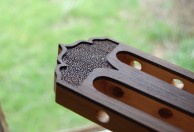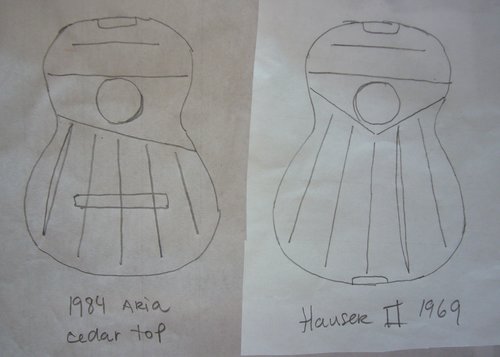Welcome to one of the most active flamenco sites on the Internet. Guests can read most posts but if you want to participate click here to register.
This site is dedicated to the memory of Paco de Lucía, Ron Mitchell, Guy Williams, Linda Elvira, Philip John Lee, Craig Eros, Ben Woods, David Serva and Tom Blackshear who went ahead of us.
We receive 12,200 visitors a month from 200 countries and 1.7 million page impressions a year. To advertise on this site please contact us.
|

|
|
RE: Harmonic bars
|
You are logged in as Guest
|
|
Users viewing this topic: none
|
|
Login  | |
|

   
BarkellWH
Posts: 3458
Joined: Jul. 12 2009
From: Washington, DC

|
 RE: Harmonic bars (in reply to Andy Culpepper) RE: Harmonic bars (in reply to Andy Culpepper)
|
|
|
Andy, I would just like to say that you started a very interesting thread and discussion among luthiers. You, Anders, Echi, Stephen, Tom, John and other luthiers have important and interesting things to say, not only among yourselves, but for those of us who are non-luthiers as well. It is great to see you guys carrying on this discussion, and we all gain from it.
Bill
_____________________________
And the end of the fight is a tombstone white,
With the name of the late deceased,
And the epitaph drear, "A fool lies here,
Who tried to hustle the East."
--Rudyard Kipling
|
|
|
|
REPORT THIS POST AS INAPPROPRIATE |
Date May 11 2016 13:31:00
 |
|

   
Andy Culpepper
Posts: 3023
Joined: Mar. 30 2009
From: NY, USA

|
 RE: Harmonic bars (in reply to BarkellWH) RE: Harmonic bars (in reply to BarkellWH)
|
|
|
quote:
Andy, I would just like to say that you started a very interesting thread and discussion among luthiers. You, Anders, Echi, Stephen, Tom, John and other luthiers have important and interesting things to say, not only among yourselves, but for those of us who are non-luthiers as well. It is great to see you guys carrying on this discussion, and we all gain from it.
Bill
Thanks for that Bill, I'm glad you're enjoying it and I'm happy to see that it hasn't gone off the rails at all yet! 
On my guitars I do arch the lower harmonic bar slightly. Basically the dishing of my solera continues to what would be about the middle of the soundhole, so there is still a slight curve below the hole.
_____________________________
Andy Culpepper, luthier
http://www.andyculpepper.com
|
|
|
|
REPORT THIS POST AS INAPPROPRIATE |
Date May 12 2016 0:13:42
 |
|

   
estebanana
Posts: 9351
Joined: Oct. 16 2009

|
 RE: Harmonic bars (in reply to Ricardo) RE: Harmonic bars (in reply to Ricardo)
|
|
|
quote:
Any insight to the Hauser II curved harmonic bar? Does it add anything sound wise by doing that?
This is speculation and I have not made enough of them to test this yet, but I think opening up more free soundboard area can potentially lower the main top resonance. The Hauser II, like yours, have a "Vee" shaped braced, I think builders after Hauser II interpreted that Vee into a curve. I'm not sure if Hauser II did or did not make them with curved braces.
Here is how it feels to me and this is unscientific, so take it for what it's worth knowing that. When the brace is swept back it opens more space along the grain on each side of the sound hole. Instead of stopping the top with a straight across brace the curved brace lets the long the grain movement be more free if the top is thick like they made them, then that lets is be more free because it has strength from it's thickness. He uses parabolic shaped fan braces and points them at about the 13th or 14th fret splaying them out wide and at a good angle. Generally speaking that wide fan placement creates stiffness that supports high frequency , the trebles benefit. But bass favors support from low frequency that is the noticable rumble of the a vibrating top, he could have been opening the top space a bit to favor a looser over all top that could chip into bass production.
The Hauser II design looks like it is a treble producer, my intuition is that he was trying to add low frequency support area. I have made one with a straight across bar too, it seems slightly different. So my best guess is that the open area helps lower main air and top resonance and supports bass in a system that generally makes bold trebles. I also have a hunch and this is also speculation not to be taken as fact, that lower top and main air resonance has a relationship with how the guitar eats string/nail attack noise. Right now I am working with this system on my intended "classical" guitars to get pure as possible notes with as little possible nail attack noise. If we were not so far apart I would send the one I have finished and unsold for you and your mom to play and give feed back.
The three models I picked to work out classical guitar sound are Hauser I and Hauser II and I am going to also make the Romanillos with the open lateral braces and the fans poking through them. The flamencos I do, pretty much always have, as the Santos - Barbero thing on spruce, but I want to use something with more support on cedar so the Bellido stuff looks pretty interesting to me.
_____________________________
https://www.stephenfaulkguitars.com
|
|
|
|
REPORT THIS POST AS INAPPROPRIATE |
Date May 12 2016 6:25:43
 |
|

   
Ricardo
Posts: 14801
Joined: Dec. 14 2004
From: Washington DC

|
 RE: Harmonic bars (in reply to estebanana) RE: Harmonic bars (in reply to estebanana)
|
|
|
quote:
This is speculation and I have not made enough of them to test this yet, but I think opening up more free soundboard area can potentially lower the main top resonance. The Hauser II, like yours, have a "Vee" shaped braced, I think builders after Hauser II interpreted that Vee into a curve. I'm not sure if Hauser II did or did not make them with curved braces.
Actually, if you have the Sheldon Urlik book, guitar 52 is the 1962 Hauser II, the pattern is shown, and the guitar I have is just like that one. The harmonic bar is not the V version, it is that gentle "U" curved shape. I get that classical guitars are what they are vs more static flamenco patterns, but I can tell that if the bridge was lower, the guitar could work fine for flamenco stuff. Maybe too much sustain for some folks, but the brightness and attack are good. If the curve adds bass to a treble strong pattern, as you suspect, it could be something to think about.
Ricardo
_____________________________
CD's and transcriptions available here:
www.ricardomarlow.com
|
|
|
|
REPORT THIS POST AS INAPPROPRIATE |
Date May 13 2016 3:54:26
 |
|

   
Echi
Posts: 1132
Joined: Jan. 11 2013

|
 RE: Harmonic bars (in reply to RobJe) RE: Harmonic bars (in reply to RobJe)
|
|
|
quote:
Any thoughts on how or why some guitars eat nail attack noise and other guitars don't?
I have some ideas as a result of some tests I did in my classical guitars (mostly following the Romanillos pattern).
The last test was just to shave down the bracing in some points and prove to be effective, at least for that guitar.
The problem here is that there are so many variables in guitar building that we should have time and space to discuss it properly and to read the things in the proper context.
It's a matter of fact that this is not the best place for someone like me to do it, either because of language problems or because such a discussion needs of generalisations and contextualisations. At least here in the forum.
If after any generalisation someone feels the need to specify that everything is possible in lutherie, there's no point even to start then.
Anyway, my understanding is that for that purpose it's fondamental the 3 cm wide area just behind the low harmonic bar (where the fingers hit the strings the most): the thickest and braceless that area, the softer the attack.
Of course this works strictly in relation with the shape of the harmonic bar itself. I have made my trials to guitars with a low harmonic bar in the Centre.
To use a bent harmonic bar can practically end up achieving the same result in a different way.
Practically speaking, everybody shapes the fan struts close to the harmonic bar.
You can do it the Torres way (similar to what Andy does) or the Hauser way, with a long, gradual shape that end up to a poor support close to the harmonic bar.
I noticed that often, guitars with a strong attack (let say the Condes) have the 3rd and 5th fan struts even touching the harmonic bars, while many soft attack guitars (those I had or those examined) I found were with no brace support at all down there.
Another important aspect is the low frequency of the box air.
I won't start speaking of vibrational modes here. Take it just for what it is and as a suggestion
|
|
|
|
REPORT THIS POST AS INAPPROPRIATE |
Date May 13 2016 9:51:30
 |
|

   
Richard Jernigan
Posts: 3430
Joined: Jan. 20 2004
From: Austin, Texas USA

|
 RE: Harmonic bars (in reply to Tom Blackshear) RE: Harmonic bars (in reply to Tom Blackshear)
|
|
|
Nail noise:
I have two classicals that exemplify this. The Abel Garcia spruce/Brazilian has top bracing more like Santos than any other published pattern I have seen. Seven fans, with a treble side "cutoff" that is taller than the fan braces. It angles across the harmonic bar ends of the treble fans, making them shorter than those on the bass side. The lower harmonic bar has openings that let the treble cutoff and the outer bass fan through. The guitar has a wide tonal range, it can be mellow or quite brilliant. It has the best 2nd and 3rd strings of any classical guitar I have become familiar with. You have to be careful not to scrape the nails across the string if you don't want to hear that high frequency hiss.
The 1973 Romanillos spruce/Indian has a thicker top, seven fans laid out symmetrically. It is "modeled on" a 1950 Hauser. The fan struts are not as high as on the Garcia, the lower harmonic bar has no openings. This guitar has a stiffer pulsacion than the Garcia, and requires a precise right hand attack to get its wide tonal range. After playing the Garcia for a week, it takes me 15 or 20 minutes to accommodate to the Romanillos. It deifinitely puts out less of the highest frequency overtones than the Garcia, but it still has a beautiful voice, once you adjust to producing it. It "eats" the high frequency hiss of nails scraped across the strings, but can still give a sharp attack when wanted. With the right hand near the bridge, it gives a more metallic sound than the Garcia.
Both are great guitars, and I feel fortunate to have them.
RNJ
|
|
|
|
REPORT THIS POST AS INAPPROPRIATE |
Date May 13 2016 17:27:47
 |
|

   
estebanana
Posts: 9351
Joined: Oct. 16 2009

|
 RE: Harmonic bars (in reply to Ricardo) RE: Harmonic bars (in reply to Ricardo)
|
|
|
quote:
I will say the bright clicking of nails on the strings and zipping of fretboard fingers across the strings are due to the very higher frequencies. When bass strings die brightness is lost and with it goes a lot of the string noises of a new set of strings. Old trebles however can have a bad overly bright sound when dying I think because they wear and lower action and slap the frets more. For sure when a set of strings is new and settled (not stretching) the guitars seem brighter due to the upper harmonics sparkling in tune with each other.
I pretty much know what the other guitar makers here will say on stuff at this point, so I have hatched this novel plan to ask guitar players about how to build guitars.
What you say confirms what I was thinking, that high frequency activity contributes to the amount of incidental sound made by the actual touching and application of hand and nail to string.
High frequency is interesting because too much emphasis on it is annoying and too little is lackluster, or so it pretends to be. It can also be detrimental when the high frequency activity is not as you say sympathetic, but out of phase. When higher partials are out of whack with each other and over active extraneous noise accumulates. I think intonation has a lot do do with this, well intonated instruments and healthy round strings help keep the overtone series from being out of control.
I'm not super fixated on extraneous noise from hands in strings for flamenco guitars, but too much is not good. But there is a link or relationship between string overtone generation, treble and projection that I am interested in for a "classical " format where less string noise has value. Both sales value and musical value.
I get the reason people talk about power, but I think there are underlying things that are more important and power is a by-product of those things. It's fairly easy to build for raw power, but it is deceptive because power at the guitar or even articulation are instant gratification issues for me. We like guitars that speak right away, have fast articulation, blah blah blah, all the things that add up to easy to play and instantly gratifying.
But does power you perceive at the guitar equate to power that is projection? I'm exploring the idea, again, that there are trades off between instant gratification under your ear at the guitar, and more difficult to play instruments that give a rarer quality.
What do you think about guitars that do not sound BIG under your ear, but sound enormous 20-30 feet away? Not blown up sound, but penetrating sound, highly focused at long range. Yet under the ear not "explosive".
_____________________________
https://www.stephenfaulkguitars.com
|
|
|
|
REPORT THIS POST AS INAPPROPRIATE |
Date May 14 2016 3:22:22
 |
|
 New Messages New Messages |
 No New Messages No New Messages |
 Hot Topic w/ New Messages Hot Topic w/ New Messages |
 Hot Topic w/o New Messages Hot Topic w/o New Messages |
 Locked w/ New Messages Locked w/ New Messages |
 Locked w/o New Messages Locked w/o New Messages |
|
 Post New Thread
Post New Thread
 Reply to Message
Reply to Message
 Post New Poll
Post New Poll
 Submit Vote
Submit Vote
 Delete My Own Post
Delete My Own Post
 Delete My Own Thread
Delete My Own Thread
 Rate Posts
Rate Posts
|
|
|
Forum Software powered by ASP Playground Advanced Edition 2.0.5
Copyright © 2000 - 2003 ASPPlayground.NET |
0.109375 secs.
|


 Printable Version
Printable Version












 I think its already a very nice guitar but I know that in 3 - 5 years time it´ll sound quite different and that its especially the trebles that will devellop, be brighter and stronger.
I think its already a very nice guitar but I know that in 3 - 5 years time it´ll sound quite different and that its especially the trebles that will devellop, be brighter and stronger. 
 New Messages
New Messages No New Messages
No New Messages Hot Topic w/ New Messages
Hot Topic w/ New Messages Hot Topic w/o New Messages
Hot Topic w/o New Messages Locked w/ New Messages
Locked w/ New Messages Locked w/o New Messages
Locked w/o New Messages Post New Thread
Post New Thread